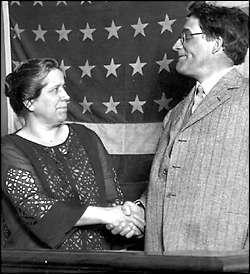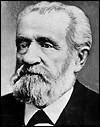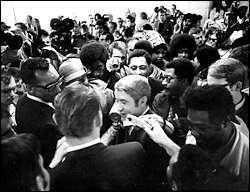 |
| City Council President Bertha Landes shakes hands with Mayor Edwin Brown in 1925. Landes was elected mayor in 1926, becoming the first woman to head a major U.S. city. |
So a successful businessman becomes mayor of Seattle and finds himself besieged by street riots and economic gloom, by a collapsed transit project and a troubled police force. Eventually, hizonner is clobbered with a bullhorn, and the man accused of wielding it promptly files to run against the embattled mayor.
How weird is that?
About par for a city with a political history wilder than this, or any mayor, had bargained for.
As with any city, Seattle's mayor catches flak for everything from barking dogs to water shortages. Hizonner also serves as a lightning rod for labor strikes and racial tensions and police corruption.
It's a wonder anybody wants the job. Except, at $126,616 a year, it pays better than most.
Since its founding 150 years ago this fall, Seattle has had 50 mayors. There have been two Mayor Smiths and two Mayor Millers, a Mayor Black and a Mayor Brown and a Mayor White, a Stone and a Wood, a Rice and a Weed and a Gill.
All except two have been white males, most of them businessmen or lawyers. Most originally came from somewhere else, which was never much of an issue with Seattle voters.
Mayors of Seattle
Seattle's first mayor, Henry Atkins, was appointed by the territorial Legislature pending the first city election scheduled for July 1870. Here are the mayors who followed, the date their term began and their political party. |
|
Until very recently, they were mostly Republicans, interspersed with an occasional Democrat or independent elected as an alternative to a fallen Republican.
They lasted anywhere from three weeks to 12 years in office. At first, the term was just one year, changing to two years in 1890 and four years in the 1940s. Until recently, mayors tended to last just one term, after which most either quit or were kicked out by voters, only to be replaced by someone equally forgettable.
A few, however, managed to make at least a temporary splash. There was William Wood, who quit to seek his fortune in the Klondike gold rush. There was Ole Hanson, who briefly became a national celebrity for going chin to chin with a citywide labor strike. There was Hiram Gill, who was indicted for corruption, and Bertha Landes, the first woman elected to lead a major U.S. city, who crusaded against corruption and bad drivers.
Some saw being mayor as a steppingstone to greater glory, but history suggests that has never been a very wise strategy. The only Seattle mayor to get a political promotion was Arthur Langlie, who served from 1938 to 1941, when he was elected governor. Since then several have tried without success; the Other Washington has no interest in being governed by a Seattle mayor.
Here's a glimpse at a century and a half of highlights, and lowlifes, down at Seattle City Hall:
 |
| Henry Yesler, a Seattle founder, was mayor in 1874-75 and 1885-86. |
Henry Yesler (terms of office: 1874-75, 1885-86) is the only one of the city founders who showed much of a stomach for politics. Twenty years after setting up his famous sawmill on the shore in Pioneer Square, Yesler served a year in the job, then staged a comeback 10 years later.
Frank Black (1896) was nominated, elected and installed over his own protests. He resigned after three weeks, earning distinction as the shortest-serving mayor in city history.
William Wood (1896-97), a lawyer and real-estate speculator who developed property around Green Lake, was appointed to replace Black. All went well until the steamer Portland showed up with its legendary "ton of gold" from the Klondike. Wood, who was attending a Christian conference in San Francisco, resigned and formed a shipping company, selling passage to the goldfields for $300 a head.
Richard Ballinger (1904-06) earned his notoriety after he left City Hall and was appointed secretary of the interior under President Taft. There he engaged in a running feud with Gifford Pinchot, the founder of the U.S. Forest Service. The squabble over oil and development in Alaska (Ballinger was for it, Pinchot against) eventually split the Republican Party.
Hiram Gill (1910-11, 1914-18), was elected to the City Council, and became embroiled in a battle over whether Seattle should be an "open town," as in open to gambling and prostitution. As mayor, Gill appointed a police chief who collected bribes from prostitutes and tolerated gambling at about 40 joints downtown. In 1911, after less than a year on the job, voters forced a recall election and dumped him.
Gill wasn't finished. In 1914, he resurfaced as a "closed-town" candidate and won. It didn't last. In 1917, he and his chief were charged with accepting bribes from bootleggers, and he was booted out for good.
George Cotterill (1912-14) was arguably the first true liberal Democrat to hold the office. An English-born surveyor, he worked with Seattle's famous city engineer, R.H. Thompson, on the Cedar River Water system and the massive landfills south of Pioneer Square that now are home to stadiums.
Cotterill supported women's suffrage, prohibition, port development and public ownership of electricity and other utilities. In 1912, he was elected mayor with support from women who were fed up with the city's tolerance of vice. But he ran afoul of his own police department and the local establishment. In 1914, he gave up city politics, ran unsuccessfully for the U.S. Senate and served out his career with various state and county jobs.
Ole Hanson (1918-19) would have been easily forgotten had he not held the job when Seattle's unions staged the famous General Strike of 1919, with 60,000 workers across the city walking off their jobs. Hanson, who had been considered pro-labor, stood his ground and suddenly found himself a national celebrity with articles in four national magazines.
Hanson quit his day job and set off on the national lecture circuit. He wrote a book, "Americanism Versus Bolshevism," with an eye toward running for president. But after his moment in the sun, Hanson limped home, sold off his property and moved to California.
Bertha Landes (1926-28) became the first female mayor of a major U.S. city by crusading for "municipal housekeeping," which meant cracking down on bootlegging, dance halls, corruption and reckless drivers. She lasted only one term, but her cleanup appeared to last far longer.
John Dore (1932-34, 1936-38), a Boston-born lawyer, served two terms during the Depression, attempting to strike an alliance with unions and thousands of unemployed. But he ran afoul of the Republican City Council when he tried to rebuild the city's streetcar system. He died in 1938 before completing his term.
William Devin (1942-52) was mayor for 10 turbulent years when Japanese Americans were hauled off to internment camps and thousands of African Americans moved here as soldiers at Fort Lawton or to help build Boeing bombers. When race riots broke out in Seattle and other U.S. cities, Devin formed a Civic Unity Committee to address the problems.
"The real problem of racial tension is fraught with deeply rooted fears that have brought about prejudices," he said in a 1944 speech. "It is our duty as citizens to face the problem together. If we do not do that, we shall not exist very long as a civilized city or as a nation."
Gordon Clinton (1956-64) is a Seattle lawyer, now retired, who held the job during the relatively quiet years when the city built a new City Hall, using plans from a Texas building, and staged a successful World's Fair.
J.D. "Dorm" Braman (1964-69) was the last Republican to hold the job.
 |
| Mayor Wes Uhlman sings with protesters at the airport in 1969. Uhlman presided during a turbulent period but may have been the city's most successful mayor. |
Wes Uhlman (1969-77) presided during yet another turbulent period, when the city was beset by a downturn at Boeing, by student demonstrations that spilled onto the new Interstate 5 freeway, by more racial tensions and a series of Central Area bombings.
But Uhlman was arguably the most powerful, and perhaps successful, mayor in the city's history. Armed with a new charter that gave him sweeping budgetary powers, Uhlman presided over the restoration of Pioneer Square and the Pike Place Market, construction of the Kingdome and the arrival of major-league sports, public funding for the arts and more.
"No mayor will ever be able to put together that kind of list again," Paul Schell said later. "And all this from a mayor that nobody ever liked very much."
Charles Royer (1978-89) is the former KING-TV news commentator who beat Schell and others in a wide-open election in 1977. Royer was far more popular than Uhlman and served 12 years — longer than any other mayor. But his management style was more diffused, and his report card never matched his predecessor's.
Norm Rice (1990-97), Seattle's first African-American mayor, held the job during the technology boom of the 1990s. He may be best-remembered for challenging a radio talk-show commentator who had been accusing the mayor of all manner of sins. After Rice's impassioned response, the radio guy was fired. And Rice became a bank president.
Sources: Seattle Times files; Historylink.org; Murray Morgan, "Skid Road"; Roger Sale, "Seattle: Past to Present."
|
 Sunday, September 16, 2001 - 12:00 a.m. Pacific
Sunday, September 16, 2001 - 12:00 a.m. Pacific

